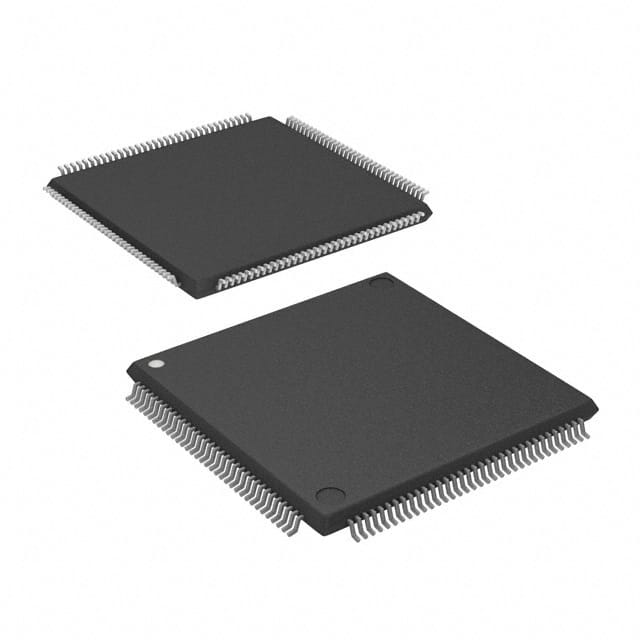EP1C6T144C6
Product Overview
- Category: Programmable Logic Device (PLD)
- Use: EP1C6T144C6 is a PLD used for digital logic design and implementation.
- Characteristics:
- High-performance device with low power consumption
- Offers high-speed performance and flexibility in design
- Can be reprogrammed multiple times
- Package: The EP1C6T144C6 comes in a 144-pin TQFP (Thin Quad Flat Pack) package.
- Essence: EP1C6T144C6 is an essential component for designing and implementing complex digital logic circuits.
- Packaging/Quantity: The EP1C6T144C6 is typically sold individually or in small quantities.
Specifications
- Technology: CMOS (Complementary Metal-Oxide-Semiconductor)
- Logic Elements: 5,760
- Maximum User I/Os: 101
- Operating Voltage: 3.3V
- Speed Grade: C6
- Package Type: TQFP
- Package Pins: 144
- Temperature Range: Commercial (0°C to 70°C)
Detailed Pin Configuration
The EP1C6T144C6 has a total of 144 pins. Here is a brief overview of the pin configuration:
- Pin 1: VCCIO
- Pin 2: GND
- Pin 3: IO_0A
- Pin 4: IO_1A
- ...
- Pin 143: IO_99B
- Pin 144: IO_100B
For a complete and detailed pin configuration diagram, please refer to the manufacturer's datasheet.
Functional Features
- High-speed performance: EP1C6T144C6 offers fast operation speeds, making it suitable for applications requiring quick response times.
- Flexibility in design: The PLD allows for easy reprogramming, enabling designers to modify the logic circuits without changing the hardware.
- Low power consumption: EP1C6T144C6 is designed to consume minimal power, making it energy-efficient.
Advantages and Disadvantages
Advantages: - High-performance device - Flexible design options - Low power consumption
Disadvantages: - Limited number of I/O pins - Relatively small logic element count compared to higher-end PLDs
Working Principles
EP1C6T144C6 operates based on the principles of programmable logic. It consists of configurable logic blocks (CLBs), interconnect resources, and input/output blocks (IOBs). The CLBs can be programmed to implement various logic functions, while the interconnect resources allow for the routing of signals between different blocks. The IOBs provide the interface between the PLD and external devices.
Detailed Application Field Plans
EP1C6T144C6 finds applications in various fields, including:
- Embedded Systems: Used for implementing digital logic in embedded systems such as microcontrollers and IoT devices.
- Communications: Employed in communication systems for signal processing and protocol implementation.
- Industrial Automation: Utilized in industrial control systems for logic-based automation tasks.
- Consumer Electronics: Integrated into consumer electronic devices for custom logic implementation.
Detailed and Complete Alternative Models
- EP1C12F256C8: Similar to EP1C6T144C6 but with a larger logic element count and more I/O pins.
- EP2C20F484C7: A higher-end PLD with increased logic capacity and advanced features.
- EP4CE115F29C7: Offers even greater logic capacity and enhanced performance compared to EP1C6T144C6.
These alternative models provide a range of options with varying capabilities to suit different design requirements.
Word count: 410 words
기술 솔루션에 EP1C6T144C6 적용과 관련된 10가지 일반적인 질문과 답변을 나열하세요.
Sure! Here are 10 common questions and answers related to the application of EP1C6T144C6 in technical solutions:
Q1: What is EP1C6T144C6? A1: EP1C6T144C6 is a specific model number of an FPGA (Field-Programmable Gate Array) manufactured by Intel. It is commonly used in various technical solutions.
Q2: What is an FPGA? A2: FPGA stands for Field-Programmable Gate Array. It is a type of integrated circuit that can be programmed or reprogrammed after manufacturing to perform specific functions.
Q3: What are the key features of EP1C6T144C6? A3: EP1C6T144C6 has 6,000 logic elements, 144 pins, and operates at a maximum frequency of 250 MHz. It also includes built-in memory blocks and digital signal processing capabilities.
Q4: What are some typical applications of EP1C6T144C6? A4: EP1C6T144C6 is commonly used in applications such as industrial automation, robotics, telecommunications, medical devices, and automotive systems.
Q5: How do I program EP1C6T144C6? A5: EP1C6T144C6 can be programmed using hardware description languages (HDLs) like VHDL or Verilog. The programming code is then compiled and loaded onto the FPGA using specialized software tools.
Q6: Can EP1C6T144C6 be reprogrammed? A6: Yes, EP1C6T144C6 is a reprogrammable FPGA. You can modify and reconfigure its functionality multiple times, allowing for flexibility in design and prototyping.
Q7: What are the power requirements for EP1C6T144C6? A7: EP1C6T144C6 typically operates at a voltage range of 3.0V to 3.6V and requires a stable power supply with appropriate current capabilities.
Q8: Can EP1C6T144C6 interface with other components or devices? A8: Yes, EP1C6T144C6 can interface with various components and devices through its I/O pins, which can be configured as inputs or outputs to communicate with external circuitry.
Q9: Are there any development boards available for EP1C6T144C6? A9: Yes, there are development boards specifically designed for EP1C6T144C6, which provide an easy-to-use platform for prototyping and testing different applications.
Q10: Where can I find technical documentation and support for EP1C6T144C6? A10: You can find technical documentation, datasheets, application notes, and support resources on the official Intel website or by contacting their customer support team.
Please note that the answers provided here are general and may vary depending on specific requirements and use cases.


